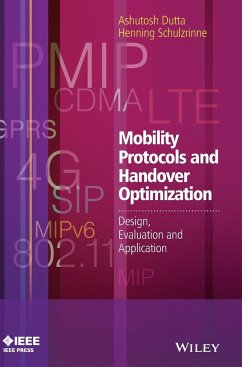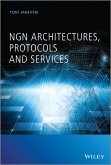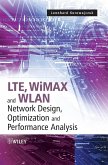Ashutosh Dutta, Henning Schulzrinne
Mobility Protocols and Handover Optimization
Design, Evaluation and Application
Ashutosh Dutta, Henning Schulzrinne
Mobility Protocols and Handover Optimization
Design, Evaluation and Application
- Gebundenes Buch
- Merkliste
- Auf die Merkliste
- Bewerten Bewerten
- Teilen
- Produkt teilen
- Produkterinnerung
- Produkterinnerung
This book provides a common framework for mobility management that considers the theoretical and practical aspects of systems optimization for mobile networks.
In this book, the authors show how an optimized system of mobility management can improve the quality of service in existing forms of mobile communication. Furthermore, they provide a theoretical approach to mobility management, as well as developing the model for systems optimization, including practical case studies using network layer and mobility layer protocols in different deployment scenarios. The authors also address the…mehr
Andere Kunden interessierten sich auch für
![Protocols and Architectures for Wireless Protocols and Architectures for Wireless]() Holger KarlProtocols and Architectures for Wireless98,99 €
Holger KarlProtocols and Architectures for Wireless98,99 €![Radio Protocols for Lte and Lte-Advanced Radio Protocols for Lte and Lte-Advanced]() Seungjune YiRadio Protocols for Lte and Lte-Advanced171,99 €
Seungjune YiRadio Protocols for Lte and Lte-Advanced171,99 €![GSM - Architecture, Protocols and Services GSM - Architecture, Protocols and Services]() Jörg EberspächerGSM - Architecture, Protocols and Services160,99 €
Jörg EberspächerGSM - Architecture, Protocols and Services160,99 €![Protocols and Architectures for Wireless Sensor Networks Protocols and Architectures for Wireless Sensor Networks]() Holger KarlProtocols and Architectures for Wireless Sensor Networks176,99 €
Holger KarlProtocols and Architectures for Wireless Sensor Networks176,99 €![NGN Architectures, Protocols and Services NGN Architectures, Protocols and Services]() Toni JanevskiNGN Architectures, Protocols and Services128,99 €
Toni JanevskiNGN Architectures, Protocols and Services128,99 €![Lte, Wimax and Wlan Network Design, Optimization and Performance Analysis Lte, Wimax and Wlan Network Design, Optimization and Performance Analysis]() Leonhard Korowajczuk (Hrsg.)Lte, Wimax and Wlan Network Design, Optimization and Performance Analysis200,99 €
Leonhard Korowajczuk (Hrsg.)Lte, Wimax and Wlan Network Design, Optimization and Performance Analysis200,99 €![Algorithms and Protocols for Wireless and Mobile AD Hoc Networks Algorithms and Protocols for Wireless and Mobile AD Hoc Networks]() Algorithms and Protocols for Wireless and Mobile AD Hoc Networks184,99 €
Algorithms and Protocols for Wireless and Mobile AD Hoc Networks184,99 €-
-
-
This book provides a common framework for mobility management that considers the theoretical and practical aspects of systems optimization for mobile networks.
In this book, the authors show how an optimized system of mobility management can improve the quality of service in existing forms of mobile communication. Furthermore, they provide a theoretical approach to mobility management, as well as developing the model for systems optimization, including practical case studies using network layer and mobility layer protocols in different deployment scenarios. The authors also address the different ways in which the specific mobility protocol can be developed, taking into account numerous factors including security, configuration, authentication, quality of service, and movement patterns of the mobiles.
Key Features:
Defines and discusses a common set of optimization methodologies and their application to all mobility protocols for both IPv4 and IPv6 networks
Applies these technologies in the context of various layers: MAC layer, network layer, transport layer and application layer covering 802.11, LTE, WiMax, CDMA networks and protocols such as SIP, MIP, HIP, VoIP, and many more
Provides a thorough analysis of the required steps during a mobility event such as discovery, network selection, configuration, authentication, security association, encryption, binding update, and media direction
Includes models and tables illustrating the analysis of mobility management as well as architecture of sample wireless and mobility test beds built by the authors, involving inter-domain and intra-domain mobility scenarios
This book is an excellent resource forprofessionals and systems architects in charge of designing wireless networks for commercial (3G/4G), LTE, IMS, military and Ad Hoc environment. It will be useful deployment guide for the architects wireless service providers. Graduate students, researchers in industry and academia, and systems engineers will also find this book of interest.
Hinweis: Dieser Artikel kann nur an eine deutsche Lieferadresse ausgeliefert werden.
In this book, the authors show how an optimized system of mobility management can improve the quality of service in existing forms of mobile communication. Furthermore, they provide a theoretical approach to mobility management, as well as developing the model for systems optimization, including practical case studies using network layer and mobility layer protocols in different deployment scenarios. The authors also address the different ways in which the specific mobility protocol can be developed, taking into account numerous factors including security, configuration, authentication, quality of service, and movement patterns of the mobiles.
Key Features:
Defines and discusses a common set of optimization methodologies and their application to all mobility protocols for both IPv4 and IPv6 networks
Applies these technologies in the context of various layers: MAC layer, network layer, transport layer and application layer covering 802.11, LTE, WiMax, CDMA networks and protocols such as SIP, MIP, HIP, VoIP, and many more
Provides a thorough analysis of the required steps during a mobility event such as discovery, network selection, configuration, authentication, security association, encryption, binding update, and media direction
Includes models and tables illustrating the analysis of mobility management as well as architecture of sample wireless and mobility test beds built by the authors, involving inter-domain and intra-domain mobility scenarios
This book is an excellent resource forprofessionals and systems architects in charge of designing wireless networks for commercial (3G/4G), LTE, IMS, military and Ad Hoc environment. It will be useful deployment guide for the architects wireless service providers. Graduate students, researchers in industry and academia, and systems engineers will also find this book of interest.
Hinweis: Dieser Artikel kann nur an eine deutsche Lieferadresse ausgeliefert werden.
Produktdetails
- Produktdetails
- Verlag: Wiley & Sons
- 1. Auflage
- Seitenzahl: 476
- Erscheinungstermin: Mai 2014
- Englisch
- Abmessung: 250mm x 175mm x 30mm
- Gewicht: 999g
- ISBN-13: 9780470740583
- ISBN-10: 0470740582
- Artikelnr.: 34160215
- Herstellerkennzeichnung
- Libri GmbH
- Europaallee 1
- 36244 Bad Hersfeld
- gpsr@libri.de
- Verlag: Wiley & Sons
- 1. Auflage
- Seitenzahl: 476
- Erscheinungstermin: Mai 2014
- Englisch
- Abmessung: 250mm x 175mm x 30mm
- Gewicht: 999g
- ISBN-13: 9780470740583
- ISBN-10: 0470740582
- Artikelnr.: 34160215
- Herstellerkennzeichnung
- Libri GmbH
- Europaallee 1
- 36244 Bad Hersfeld
- gpsr@libri.de
Dr. Ashutosh Dutta Dr. Ashutosh Dutta obtained his Ph.D. in EE from Columbia University, M.S. in Computer Science from NJIT, USA and BSEE from NIT, Rourkela, India. As a seasoned mobility and security architect and an accomplished networking and computer science expert with 20-plus years experience, Ashutosh directed multiple IT operations, led the research and development for leading global technology corporations and top university and has in-depth expertise in developing and implementing research, analysis and design initiatives. His career spanning 25 years includes LMTS (Lead Member of Technical Staff) at AT&T, NJ; CTO Wireless at NIKSUN, NJ; Senior Scientist in Telcordia Technologies, NJ; CRF Director at Columbia University, NY and Computer Engineer with TATA Motors, India. Ashutosh's research interests include wireless Internet, multimedia signaling, mobility management, 4G networks, IMS (IP Multimedia Subsystems), VoIP and session control protocols. He has published more than 80 conference, journal papers and Internet drafts, three book chapters, and has given tutorials in mobility management at various conferences. Ashutosh has 19 issued security and mobility related US patents. Ashutosh is a senior member of IEEE and ACM. He has served as an IEEE volunteer and leader at the section, region, chapter, society, MGA, and EAB level. Ashutosh is recipient of the 2009 IEEE Region 1, IEEE MGA and 2010 IEEE-USA Leadership Awards. Prof. Henning Schulzrinne Prof. Henning Schulzrinne, Levi Professor of Computer Science at Columbia University, received his Ph.D. from the University of Massachusetts in Amherst, Massachusetts. He was an MTS at AT&T Bell Laboratories and an associate department head at GMD-Fokus (Berlin), before joining the Computer Science and Electrical Engineering departments at Columbia University. He served as chair of the Department of Computer Science from 2004 to 2009, as Engineering Fellow at the US Federal Communications Commission (FCC) in 2010 and 2011, and as Chief Technology Officer at the FCC since 2012. He has published more than 250 journal and conference papers, and more than 70 Internet RFCs. Protocols co-developed by him, such as RTP, RTSP and SIP, are now Internet standards, used by almost all Internet telephony and multimedia applications. His research interests include Internet multimedia systems, ubiquitous computing, and mobile systems. He is a Fellow of the IEEE, has received the New York City Mayor's Award for Excellence in Science and Technology, the VON Pioneer Award, TCCC service award, the IEEE Region 1 William Terry Award for Lifetime Distinguished Service to IEEE and the UMass Computer Science Outstanding Alumni recognition.
About the Authors xv
Foreword xvii
Preface xix
Acknowledgements xxiii
List of Abbreviations xxv
1 Introduction 1
1.1 Types of Mobility 2
1.1.1 Terminal Mobility 2
1.1.2 Personal Mobility 5
1.1.3 Session Mobility 6
1.1.4 Service Mobility 7
1.2 Performance Requirements 7
1.3 Motivation 8
1.4 Summary of Key Contributions 9
2 Analysis of Mobility Protocols for Multimedia 13
2.1 Summary of Key Contributions and Indicative Results 13
2.2 Introduction 14
2.3 Cellular 1G 15
2.3.1 System Architecture 15
2.3.2 Handoff Procedure 17
2.4 Cellular 2G Mobility 17
2.4.1 GSM 17
2.4.2 IS-95 19
2.5 Cellular 3G Mobility 23
2.5.1 WCDMA 24
2.5.2 CDMA2000 26
2.6 4G Networks 27
2.6.1 Evolved Packet System 28
2.6.2 WiMAX Mobility 31
2.7 IP-Based Mobility 34
2.7.1 Network Layer Macromobility 34
2.7.2 Network Layer Micromobility 40
2.7.3 NETMOB: Network Mobility 46
2.7.4 Transport Layer Mobility 49
2.7.5 Application Layer Mobility 49
2.7.6 Host Identity Protocol 50
2.7.7 MOBIKE 52
2.7.8 IAPP 53
2.8 Heterogeneous Handover 55
2.8.1 UMTS-WLAN Handover 55
2.8.2 LTE-WLAN Handover 58
2.9 Multicast Mobility 61
2.10 Concluding Remarks 71
3 Systems Analysis of Mobility Events 73
3.1 Summary of Key Contributions and Indicative Results 75
3.2 Introduction 75
3.2.1 Comparative Analysis of Mobility Protocols 77
3.3 Analysis of Handoff Components 78
3.3.1 Network Discovery and Selection 80
3.3.2 Network Attachment 80
3.3.3 Configuration 81
3.3.4 Security Association 81
3.3.5 Binding Update 82
3.3.6 Media Rerouting 83
3.4 Effect of Handoff across Layers 83
3.4.1 Layer 2 Delay 84
3.4.2 Layer 3 Delay 84
3.4.3 Application Layer Delay 85
3.4.4 Handoff Operations across Layers 85
3.5 Concluding Remarks 90
4 Modeling Mobility 91
4.1 Summary of Key Contributions and Indicative Results 91
4.2 Introduction 92
4.3 Related Work 92
4.4 Modeling Mobility as a Discrete-Event Dynamic System 93
4.5 Petri Net Primitives 94
4.6 Petri-Net-Based Modeling Methodologies 96
4.7 Resource Utilization during Handoff 97
4.8 Data Dependency Analysis of the Handoff Process 99
4.8.1 Petri-Net-Based Data Dependency 99
4.8.2 Analysis of Data Dependency during Handoff Process 100
4.9 Petri Net Model for Handoff 105
4.10 Petri-Net-Based Analysis of Handoff Event 113
4.10.1 Analysis of Deadlocks in Handoff 114
4.10.2 Reachability Analysis 120
4.10.3 Matrix Equations 122
4.11 Evaluation of Systems Performance Using Petri Nets 123
4.11.1 Cycle-Time-Based Approach 123
4.11.2 Floyd-Algorithm-Based Approach 124
4.11.3 Resource-Time Product Approach 125
4.12 Opportunities for Optimization 128
4.12.1 Analysis of Parallelism in Handoff Operations 129
4.12.2 Opportunities for Proactive Operation 129
4.13 Concluding Remarks 130
5 Layer 2 Optimization 131
5.1 Introduction 131
5.2 Related Work 131
5.3 IEEE 802.11 Standards 132
5.3.1 The IEEE 802.11 Wireless LAN Architecture 133
5.3.2 IEEE 802.11 Management Frames 134
5.4 Handoff Procedure with Active Scanning 135
5.4.1 Steps during Handoff 135
5.5 Fast-Handoff Algorithm 137
5.5.1 Selective Scanning 137
5.5.2 Caching 138
5.6 Implementation 142
5.6.1 The HostAP Driver 142
5.7 Measurements 142
5.7.1 Experimental Setup 142
5.7.2 The Environment 142
5.7.3 Experiments 143
5.8 Measurement Results 143
5.8.1 Handoff Time 143
5.8.2 Packet Loss 143
5.9 Conclusions and Future Work 146
6 Mobility Optimization Techniques 149
6.1 Summary of Key Contributions and Indicative Results 149
6.1.1 Discovery 149
6.1.2 Authentication 150
6.1.3 Layer 3 Configuration 151
6.1.4 Layer 3 Security Association 152
6.1.5 Binding Update 152
6.1.6 Media Rerouting 153
6.1.7 Route Optimization 154
6.1.8 Media-Independent Cross-Layer Triggers 155
6.2 Introduction 156
6.3 Discovery 156
6.3.1 Key Principles 156
6.3.2 Related Work 157
6.3.3 Application Layer Discovery 158
6.3.4 Experimental Results and Analysis 161
6.4 Authentication 164
6.4.1 Key Principles 166
6.4.2 Related Work 166
6.4.3 Network-Layer-Assisted Preauthentication 169
6.4.4 Experimental Results and Analysis 173
6.5 Layer 3 Configuration 177
6.5.1 Key Principles 179
6.5.2 Related Work 180
6.5.3 Router-Assisted Duplicate Address Detection 180
6.5.4 Proactive IP Address Configuration 180
6.5.5 Experimental Results and Analysis 183
6.6 Layer 3 Security Association 183
6.6.1 Key Principles 184
6.6.2 Related Work 184
6.6.3 Anchor-Assisted Security Association 184
6.6.4 Experimental Results and Analysis 187
6.7 Binding Update 190
6.7.1 Key Principles 191
6.7.2 Related Work 191
6.7.3 Hierarchical Binding Update 192
6.7.4 Experimental Results and Analysis 195
6.7.5 Proactive Binding Update 199
6.8 Media Rerouting 199
6.8.1 Key Principles 200
6.8.2 Related Work 200
6.8.3 Data Redirection Using Forwarding Agent 201
6.8.4 Mobility-Proxy-Assisted Time-Bound Data Redirection 202
6.8.5 Time-Bound Localized Multicasting 205
6.9 Media Buffering 210
6.9.1 Key Principles 211
6.9.2 Related Work 211
6.9.3 Protocol for Edge Buffering 212
6.9.4 Experimental Results and Analysis 215
6.9.5 Analysis of the Trade-off between Buffering Delay and Packet Loss 219
6.10 Route Optimization 220
6.10.1 Key Principles 221
6.10.2 Related Work 221
6.10.3 Maintaining a Direct Path by Application Layer Mobility 221
6.10.4 Interceptor-Assisted Packet Modifier at the End Point 222
6.10.5 Intercepting Proxy-Assisted Route Optimization 224
6.10.6 Cost Analysis and Experimental Analysis 226
6.10.7 Binding-Cache-Based Route Optimization 229
6.11 Media-Independent Cross-Layer Triggers 232
6.11.1 Key Principles 232
6.11.2 Related Work 232
6.11.3 Media Independent Handover Function 233
6.11.4 Faster Link-Down Detection Scheme 238
6.12 Concluding Remarks 241
7 Optimization with Multilayer Mobility Protocols 243
7.1 Summary of Key Contributions and Indicative Results 243
7.2 Introduction 244
7.3 Key Principles 245
7.4 Related Work 245
7.5 Multilayer Mobility Approach 246
7.5.1 Policy-Based Mobility Protocols: SIP and MIP-LR 247
7.5.2 Integration of SIP and MIP-LR with MMP 248
7.5.3 Integration of Global Mobility Protocol with Micromobility Protocol
250
7.5.4 Implementation of Multilayer Mobility Protocols 250
7.5.5 Implementation and Performance Issues 252
7.6 Concluding Remarks 255
8 Optimizations for Simultaneous Mobility 257
8.1 Summary of Key Contributions and Indicative Results 257
8.2 Introduction 258
8.2.1 Analysis of Simultaneous Mobility 258
8.3 Illustration of the Simultaneous Mobility Problem 260
8.4 Related Work 262
8.5 Key Optimization Techniques 262
8.6 Analytical Framework 262
8.6.1 Fundamental Concepts 262
8.6.2 Handoff Sequences 263
8.6.3 Binding Updates 264
8.6.4 Location Proxies and Binding Update Proxies 265
8.7 Analyzing the Simultaneous Mobility Problem 267
8.8 Probability of Simultaneous Mobility 270
8.9 Solutions 272
8.9.1 Soft Handoff 273
8.9.2 Receiver-Side Mechanisms 273
8.9.3 Sender-Side Mechanisms 275
8.10 Application of Solution Mechanisms 276
8.10.1 Mobile IPv6 277
8.10.2 MIP-LR 279
8.10.3 SIP-Based Mobility 280
8.11 Concluding Remarks 282
9 Handoff Optimization for Multicast Streaming 285
9.1 Summary of Key Contributions and Indicative Results 285
9.2 Introduction 286
9.3 Key Principles 289
9.4 Related Work 290
9.5 Mobility in a Hierarchical Multicast Architecture 291
9.5.1 Channel Announcement 293
9.5.2 Channel Management 293
9.5.3 Channel Tuning 293
9.5.4 Local Advertisement Insertion 294
9.5.5 Channel Monitor 294
9.5.6 Security 295
9.6 Optimization Techniques for Multicast Media Delivery 296
9.6.1 Reactive Triggering 296
9.6.2 Proactive Triggering 297
9.6.3 Triggering during Configuration of a Mobile 298
9.7 Experimental Results and Performance Analysis 299
9.7.1 Experimental Results 299
9.7.2 Performance Analysis 302
9.8 Concluding Remarks 305
10 Cooperative Roaming 307
10.1 Introduction 307
10.2 Related Work 309
10.3 IP Multicast Addressing 310
10.4 Cooperative Roaming 311
10.4.1 Overview 311
10.4.2 L2 Cooperation Protocol 312
10.4.3 L3 Cooperation Protocol 313
10.5 Cooperative Authentication 314
10.5.1 Overview of IEEE 802.1x 314
10.5.2 Cooperation in the Authentication Process 315
10.5.3 Relay Process 316
10.6 Security 318
10.6.1 Security Issues in Roaming 318
10.6.2 Cooperative Authentication and Security 319
10.7 Streaming Media Support 320
10.8 Bandwidth and Energy Usage 320
10.9 Experiments 321
10.9.1 Environment 321
10.9.2 Implementation Details 322
10.9.3 Experimental Setup 322
10.9.4 Results 323
10.10 Application Layer Mobility 328
10.11 Load Balancing 329
10.12 Multicast and Scalability 330
10.13 An Alternative to Multicast 330
10.14 Conclusions and Future Work 331
11 System Evaluation 333
11.1 Summary of Key Contributions and Indicative Results 333
11.2 Introduction 334
11.3 Experimental Validation 334
11.3.1 The Media Independent Preauthentication Framework 334
11.3.2 Intratechnology Handoff 338
11.3.3 Intertechnology Handoff 340
11.3.4 Cross-Layer-Trigger-Assisted Preauthentication 342
11.3.5 Mobile-Initiated Handover with 802.21 Triggers 344
11.3.6 Network-Initiated Handover with 802.21 Triggers 345
11.3.7 Handover Preparation Time 346
11.4 Handoff Optimization in IP Multimedia Subsystem 350
11.4.1 Nonoptimized Handoff Mode 350
11.4.2 Optimization with Reactive Context Transfer 351
11.4.3 Optimization with Proactive Security Context Transfer 352
11.4.4 Performance Results 353
11.5 Systems Validation Using Petri-Net-Based Models 355
11.5.1 MATLAB®-Based Modeling of Handoff Functions 356
11.5.2 Petri-Net-Based Model for Optimized Security Association 360
11.5.3 Petri-Net-Based Model for Hierarchical Binding Update 361
11.5.4 Petri-Net-Based Model for Media Redirection of In-Flight Data 362
11.5.5 Petri-Net-Based Model of Optimized Configuration 364
11.5.6 Petri-Net-Based Model for Multicast Mobility 364
11.6 Scheduling Handoff Operations 365
11.6.1 Sequential Scheduling 366
11.6.2 Concurrent Scheduling 368
11.6.3 Proactive Scheduling 368
11.7 Verification of Systems Performance 369
11.7.1 Cycle-Time-Based Approach 369
11.7.2 Using the Floyd Algorithm 370
11.8 Petri-Net-Based Modeling for Multi-Interface Mobility 371
11.8.1 Multihoming Scenario 371
11.8.2 Break-Before-Make Scenario 372
11.8.3 Make-Before-Break Scenario 372
11.8.4 MATLAB®-Based Petri Net Modeling for Multi-Interface Mobility 372
11.9 Deadlocks in Handoff Scheduling 374
11.9.1 Handoff Schedules with Deadlocks 375
11.9.2 Deadlock Prevention and Avoidance in Handoff Schedules 377
11.10 Analysis of Level of Concurrency and Resources 380
11.11 Trade-off Analysis for Proactive Handoff 385
11.12 Concluding Remarks 389
12 Conclusions 391
12.1 General Principles of Mobility Optimization 391
12.2 Summary of Contributions 393
12.3 Future Work 394
A RDF Schema for Application Layer Discovery 395
A.1 Schema Primitives 395
B Definitions of Mobility-Related Terms 399
References 409
Index 425
Foreword xvii
Preface xix
Acknowledgements xxiii
List of Abbreviations xxv
1 Introduction 1
1.1 Types of Mobility 2
1.1.1 Terminal Mobility 2
1.1.2 Personal Mobility 5
1.1.3 Session Mobility 6
1.1.4 Service Mobility 7
1.2 Performance Requirements 7
1.3 Motivation 8
1.4 Summary of Key Contributions 9
2 Analysis of Mobility Protocols for Multimedia 13
2.1 Summary of Key Contributions and Indicative Results 13
2.2 Introduction 14
2.3 Cellular 1G 15
2.3.1 System Architecture 15
2.3.2 Handoff Procedure 17
2.4 Cellular 2G Mobility 17
2.4.1 GSM 17
2.4.2 IS-95 19
2.5 Cellular 3G Mobility 23
2.5.1 WCDMA 24
2.5.2 CDMA2000 26
2.6 4G Networks 27
2.6.1 Evolved Packet System 28
2.6.2 WiMAX Mobility 31
2.7 IP-Based Mobility 34
2.7.1 Network Layer Macromobility 34
2.7.2 Network Layer Micromobility 40
2.7.3 NETMOB: Network Mobility 46
2.7.4 Transport Layer Mobility 49
2.7.5 Application Layer Mobility 49
2.7.6 Host Identity Protocol 50
2.7.7 MOBIKE 52
2.7.8 IAPP 53
2.8 Heterogeneous Handover 55
2.8.1 UMTS-WLAN Handover 55
2.8.2 LTE-WLAN Handover 58
2.9 Multicast Mobility 61
2.10 Concluding Remarks 71
3 Systems Analysis of Mobility Events 73
3.1 Summary of Key Contributions and Indicative Results 75
3.2 Introduction 75
3.2.1 Comparative Analysis of Mobility Protocols 77
3.3 Analysis of Handoff Components 78
3.3.1 Network Discovery and Selection 80
3.3.2 Network Attachment 80
3.3.3 Configuration 81
3.3.4 Security Association 81
3.3.5 Binding Update 82
3.3.6 Media Rerouting 83
3.4 Effect of Handoff across Layers 83
3.4.1 Layer 2 Delay 84
3.4.2 Layer 3 Delay 84
3.4.3 Application Layer Delay 85
3.4.4 Handoff Operations across Layers 85
3.5 Concluding Remarks 90
4 Modeling Mobility 91
4.1 Summary of Key Contributions and Indicative Results 91
4.2 Introduction 92
4.3 Related Work 92
4.4 Modeling Mobility as a Discrete-Event Dynamic System 93
4.5 Petri Net Primitives 94
4.6 Petri-Net-Based Modeling Methodologies 96
4.7 Resource Utilization during Handoff 97
4.8 Data Dependency Analysis of the Handoff Process 99
4.8.1 Petri-Net-Based Data Dependency 99
4.8.2 Analysis of Data Dependency during Handoff Process 100
4.9 Petri Net Model for Handoff 105
4.10 Petri-Net-Based Analysis of Handoff Event 113
4.10.1 Analysis of Deadlocks in Handoff 114
4.10.2 Reachability Analysis 120
4.10.3 Matrix Equations 122
4.11 Evaluation of Systems Performance Using Petri Nets 123
4.11.1 Cycle-Time-Based Approach 123
4.11.2 Floyd-Algorithm-Based Approach 124
4.11.3 Resource-Time Product Approach 125
4.12 Opportunities for Optimization 128
4.12.1 Analysis of Parallelism in Handoff Operations 129
4.12.2 Opportunities for Proactive Operation 129
4.13 Concluding Remarks 130
5 Layer 2 Optimization 131
5.1 Introduction 131
5.2 Related Work 131
5.3 IEEE 802.11 Standards 132
5.3.1 The IEEE 802.11 Wireless LAN Architecture 133
5.3.2 IEEE 802.11 Management Frames 134
5.4 Handoff Procedure with Active Scanning 135
5.4.1 Steps during Handoff 135
5.5 Fast-Handoff Algorithm 137
5.5.1 Selective Scanning 137
5.5.2 Caching 138
5.6 Implementation 142
5.6.1 The HostAP Driver 142
5.7 Measurements 142
5.7.1 Experimental Setup 142
5.7.2 The Environment 142
5.7.3 Experiments 143
5.8 Measurement Results 143
5.8.1 Handoff Time 143
5.8.2 Packet Loss 143
5.9 Conclusions and Future Work 146
6 Mobility Optimization Techniques 149
6.1 Summary of Key Contributions and Indicative Results 149
6.1.1 Discovery 149
6.1.2 Authentication 150
6.1.3 Layer 3 Configuration 151
6.1.4 Layer 3 Security Association 152
6.1.5 Binding Update 152
6.1.6 Media Rerouting 153
6.1.7 Route Optimization 154
6.1.8 Media-Independent Cross-Layer Triggers 155
6.2 Introduction 156
6.3 Discovery 156
6.3.1 Key Principles 156
6.3.2 Related Work 157
6.3.3 Application Layer Discovery 158
6.3.4 Experimental Results and Analysis 161
6.4 Authentication 164
6.4.1 Key Principles 166
6.4.2 Related Work 166
6.4.3 Network-Layer-Assisted Preauthentication 169
6.4.4 Experimental Results and Analysis 173
6.5 Layer 3 Configuration 177
6.5.1 Key Principles 179
6.5.2 Related Work 180
6.5.3 Router-Assisted Duplicate Address Detection 180
6.5.4 Proactive IP Address Configuration 180
6.5.5 Experimental Results and Analysis 183
6.6 Layer 3 Security Association 183
6.6.1 Key Principles 184
6.6.2 Related Work 184
6.6.3 Anchor-Assisted Security Association 184
6.6.4 Experimental Results and Analysis 187
6.7 Binding Update 190
6.7.1 Key Principles 191
6.7.2 Related Work 191
6.7.3 Hierarchical Binding Update 192
6.7.4 Experimental Results and Analysis 195
6.7.5 Proactive Binding Update 199
6.8 Media Rerouting 199
6.8.1 Key Principles 200
6.8.2 Related Work 200
6.8.3 Data Redirection Using Forwarding Agent 201
6.8.4 Mobility-Proxy-Assisted Time-Bound Data Redirection 202
6.8.5 Time-Bound Localized Multicasting 205
6.9 Media Buffering 210
6.9.1 Key Principles 211
6.9.2 Related Work 211
6.9.3 Protocol for Edge Buffering 212
6.9.4 Experimental Results and Analysis 215
6.9.5 Analysis of the Trade-off between Buffering Delay and Packet Loss 219
6.10 Route Optimization 220
6.10.1 Key Principles 221
6.10.2 Related Work 221
6.10.3 Maintaining a Direct Path by Application Layer Mobility 221
6.10.4 Interceptor-Assisted Packet Modifier at the End Point 222
6.10.5 Intercepting Proxy-Assisted Route Optimization 224
6.10.6 Cost Analysis and Experimental Analysis 226
6.10.7 Binding-Cache-Based Route Optimization 229
6.11 Media-Independent Cross-Layer Triggers 232
6.11.1 Key Principles 232
6.11.2 Related Work 232
6.11.3 Media Independent Handover Function 233
6.11.4 Faster Link-Down Detection Scheme 238
6.12 Concluding Remarks 241
7 Optimization with Multilayer Mobility Protocols 243
7.1 Summary of Key Contributions and Indicative Results 243
7.2 Introduction 244
7.3 Key Principles 245
7.4 Related Work 245
7.5 Multilayer Mobility Approach 246
7.5.1 Policy-Based Mobility Protocols: SIP and MIP-LR 247
7.5.2 Integration of SIP and MIP-LR with MMP 248
7.5.3 Integration of Global Mobility Protocol with Micromobility Protocol
250
7.5.4 Implementation of Multilayer Mobility Protocols 250
7.5.5 Implementation and Performance Issues 252
7.6 Concluding Remarks 255
8 Optimizations for Simultaneous Mobility 257
8.1 Summary of Key Contributions and Indicative Results 257
8.2 Introduction 258
8.2.1 Analysis of Simultaneous Mobility 258
8.3 Illustration of the Simultaneous Mobility Problem 260
8.4 Related Work 262
8.5 Key Optimization Techniques 262
8.6 Analytical Framework 262
8.6.1 Fundamental Concepts 262
8.6.2 Handoff Sequences 263
8.6.3 Binding Updates 264
8.6.4 Location Proxies and Binding Update Proxies 265
8.7 Analyzing the Simultaneous Mobility Problem 267
8.8 Probability of Simultaneous Mobility 270
8.9 Solutions 272
8.9.1 Soft Handoff 273
8.9.2 Receiver-Side Mechanisms 273
8.9.3 Sender-Side Mechanisms 275
8.10 Application of Solution Mechanisms 276
8.10.1 Mobile IPv6 277
8.10.2 MIP-LR 279
8.10.3 SIP-Based Mobility 280
8.11 Concluding Remarks 282
9 Handoff Optimization for Multicast Streaming 285
9.1 Summary of Key Contributions and Indicative Results 285
9.2 Introduction 286
9.3 Key Principles 289
9.4 Related Work 290
9.5 Mobility in a Hierarchical Multicast Architecture 291
9.5.1 Channel Announcement 293
9.5.2 Channel Management 293
9.5.3 Channel Tuning 293
9.5.4 Local Advertisement Insertion 294
9.5.5 Channel Monitor 294
9.5.6 Security 295
9.6 Optimization Techniques for Multicast Media Delivery 296
9.6.1 Reactive Triggering 296
9.6.2 Proactive Triggering 297
9.6.3 Triggering during Configuration of a Mobile 298
9.7 Experimental Results and Performance Analysis 299
9.7.1 Experimental Results 299
9.7.2 Performance Analysis 302
9.8 Concluding Remarks 305
10 Cooperative Roaming 307
10.1 Introduction 307
10.2 Related Work 309
10.3 IP Multicast Addressing 310
10.4 Cooperative Roaming 311
10.4.1 Overview 311
10.4.2 L2 Cooperation Protocol 312
10.4.3 L3 Cooperation Protocol 313
10.5 Cooperative Authentication 314
10.5.1 Overview of IEEE 802.1x 314
10.5.2 Cooperation in the Authentication Process 315
10.5.3 Relay Process 316
10.6 Security 318
10.6.1 Security Issues in Roaming 318
10.6.2 Cooperative Authentication and Security 319
10.7 Streaming Media Support 320
10.8 Bandwidth and Energy Usage 320
10.9 Experiments 321
10.9.1 Environment 321
10.9.2 Implementation Details 322
10.9.3 Experimental Setup 322
10.9.4 Results 323
10.10 Application Layer Mobility 328
10.11 Load Balancing 329
10.12 Multicast and Scalability 330
10.13 An Alternative to Multicast 330
10.14 Conclusions and Future Work 331
11 System Evaluation 333
11.1 Summary of Key Contributions and Indicative Results 333
11.2 Introduction 334
11.3 Experimental Validation 334
11.3.1 The Media Independent Preauthentication Framework 334
11.3.2 Intratechnology Handoff 338
11.3.3 Intertechnology Handoff 340
11.3.4 Cross-Layer-Trigger-Assisted Preauthentication 342
11.3.5 Mobile-Initiated Handover with 802.21 Triggers 344
11.3.6 Network-Initiated Handover with 802.21 Triggers 345
11.3.7 Handover Preparation Time 346
11.4 Handoff Optimization in IP Multimedia Subsystem 350
11.4.1 Nonoptimized Handoff Mode 350
11.4.2 Optimization with Reactive Context Transfer 351
11.4.3 Optimization with Proactive Security Context Transfer 352
11.4.4 Performance Results 353
11.5 Systems Validation Using Petri-Net-Based Models 355
11.5.1 MATLAB®-Based Modeling of Handoff Functions 356
11.5.2 Petri-Net-Based Model for Optimized Security Association 360
11.5.3 Petri-Net-Based Model for Hierarchical Binding Update 361
11.5.4 Petri-Net-Based Model for Media Redirection of In-Flight Data 362
11.5.5 Petri-Net-Based Model of Optimized Configuration 364
11.5.6 Petri-Net-Based Model for Multicast Mobility 364
11.6 Scheduling Handoff Operations 365
11.6.1 Sequential Scheduling 366
11.6.2 Concurrent Scheduling 368
11.6.3 Proactive Scheduling 368
11.7 Verification of Systems Performance 369
11.7.1 Cycle-Time-Based Approach 369
11.7.2 Using the Floyd Algorithm 370
11.8 Petri-Net-Based Modeling for Multi-Interface Mobility 371
11.8.1 Multihoming Scenario 371
11.8.2 Break-Before-Make Scenario 372
11.8.3 Make-Before-Break Scenario 372
11.8.4 MATLAB®-Based Petri Net Modeling for Multi-Interface Mobility 372
11.9 Deadlocks in Handoff Scheduling 374
11.9.1 Handoff Schedules with Deadlocks 375
11.9.2 Deadlock Prevention and Avoidance in Handoff Schedules 377
11.10 Analysis of Level of Concurrency and Resources 380
11.11 Trade-off Analysis for Proactive Handoff 385
11.12 Concluding Remarks 389
12 Conclusions 391
12.1 General Principles of Mobility Optimization 391
12.2 Summary of Contributions 393
12.3 Future Work 394
A RDF Schema for Application Layer Discovery 395
A.1 Schema Primitives 395
B Definitions of Mobility-Related Terms 399
References 409
Index 425
About the Authors xv
Foreword xvii
Preface xix
Acknowledgements xxiii
List of Abbreviations xxv
1 Introduction 1
1.1 Types of Mobility 2
1.1.1 Terminal Mobility 2
1.1.2 Personal Mobility 5
1.1.3 Session Mobility 6
1.1.4 Service Mobility 7
1.2 Performance Requirements 7
1.3 Motivation 8
1.4 Summary of Key Contributions 9
2 Analysis of Mobility Protocols for Multimedia 13
2.1 Summary of Key Contributions and Indicative Results 13
2.2 Introduction 14
2.3 Cellular 1G 15
2.3.1 System Architecture 15
2.3.2 Handoff Procedure 17
2.4 Cellular 2G Mobility 17
2.4.1 GSM 17
2.4.2 IS-95 19
2.5 Cellular 3G Mobility 23
2.5.1 WCDMA 24
2.5.2 CDMA2000 26
2.6 4G Networks 27
2.6.1 Evolved Packet System 28
2.6.2 WiMAX Mobility 31
2.7 IP-Based Mobility 34
2.7.1 Network Layer Macromobility 34
2.7.2 Network Layer Micromobility 40
2.7.3 NETMOB: Network Mobility 46
2.7.4 Transport Layer Mobility 49
2.7.5 Application Layer Mobility 49
2.7.6 Host Identity Protocol 50
2.7.7 MOBIKE 52
2.7.8 IAPP 53
2.8 Heterogeneous Handover 55
2.8.1 UMTS-WLAN Handover 55
2.8.2 LTE-WLAN Handover 58
2.9 Multicast Mobility 61
2.10 Concluding Remarks 71
3 Systems Analysis of Mobility Events 73
3.1 Summary of Key Contributions and Indicative Results 75
3.2 Introduction 75
3.2.1 Comparative Analysis of Mobility Protocols 77
3.3 Analysis of Handoff Components 78
3.3.1 Network Discovery and Selection 80
3.3.2 Network Attachment 80
3.3.3 Configuration 81
3.3.4 Security Association 81
3.3.5 Binding Update 82
3.3.6 Media Rerouting 83
3.4 Effect of Handoff across Layers 83
3.4.1 Layer 2 Delay 84
3.4.2 Layer 3 Delay 84
3.4.3 Application Layer Delay 85
3.4.4 Handoff Operations across Layers 85
3.5 Concluding Remarks 90
4 Modeling Mobility 91
4.1 Summary of Key Contributions and Indicative Results 91
4.2 Introduction 92
4.3 Related Work 92
4.4 Modeling Mobility as a Discrete-Event Dynamic System 93
4.5 Petri Net Primitives 94
4.6 Petri-Net-Based Modeling Methodologies 96
4.7 Resource Utilization during Handoff 97
4.8 Data Dependency Analysis of the Handoff Process 99
4.8.1 Petri-Net-Based Data Dependency 99
4.8.2 Analysis of Data Dependency during Handoff Process 100
4.9 Petri Net Model for Handoff 105
4.10 Petri-Net-Based Analysis of Handoff Event 113
4.10.1 Analysis of Deadlocks in Handoff 114
4.10.2 Reachability Analysis 120
4.10.3 Matrix Equations 122
4.11 Evaluation of Systems Performance Using Petri Nets 123
4.11.1 Cycle-Time-Based Approach 123
4.11.2 Floyd-Algorithm-Based Approach 124
4.11.3 Resource-Time Product Approach 125
4.12 Opportunities for Optimization 128
4.12.1 Analysis of Parallelism in Handoff Operations 129
4.12.2 Opportunities for Proactive Operation 129
4.13 Concluding Remarks 130
5 Layer 2 Optimization 131
5.1 Introduction 131
5.2 Related Work 131
5.3 IEEE 802.11 Standards 132
5.3.1 The IEEE 802.11 Wireless LAN Architecture 133
5.3.2 IEEE 802.11 Management Frames 134
5.4 Handoff Procedure with Active Scanning 135
5.4.1 Steps during Handoff 135
5.5 Fast-Handoff Algorithm 137
5.5.1 Selective Scanning 137
5.5.2 Caching 138
5.6 Implementation 142
5.6.1 The HostAP Driver 142
5.7 Measurements 142
5.7.1 Experimental Setup 142
5.7.2 The Environment 142
5.7.3 Experiments 143
5.8 Measurement Results 143
5.8.1 Handoff Time 143
5.8.2 Packet Loss 143
5.9 Conclusions and Future Work 146
6 Mobility Optimization Techniques 149
6.1 Summary of Key Contributions and Indicative Results 149
6.1.1 Discovery 149
6.1.2 Authentication 150
6.1.3 Layer 3 Configuration 151
6.1.4 Layer 3 Security Association 152
6.1.5 Binding Update 152
6.1.6 Media Rerouting 153
6.1.7 Route Optimization 154
6.1.8 Media-Independent Cross-Layer Triggers 155
6.2 Introduction 156
6.3 Discovery 156
6.3.1 Key Principles 156
6.3.2 Related Work 157
6.3.3 Application Layer Discovery 158
6.3.4 Experimental Results and Analysis 161
6.4 Authentication 164
6.4.1 Key Principles 166
6.4.2 Related Work 166
6.4.3 Network-Layer-Assisted Preauthentication 169
6.4.4 Experimental Results and Analysis 173
6.5 Layer 3 Configuration 177
6.5.1 Key Principles 179
6.5.2 Related Work 180
6.5.3 Router-Assisted Duplicate Address Detection 180
6.5.4 Proactive IP Address Configuration 180
6.5.5 Experimental Results and Analysis 183
6.6 Layer 3 Security Association 183
6.6.1 Key Principles 184
6.6.2 Related Work 184
6.6.3 Anchor-Assisted Security Association 184
6.6.4 Experimental Results and Analysis 187
6.7 Binding Update 190
6.7.1 Key Principles 191
6.7.2 Related Work 191
6.7.3 Hierarchical Binding Update 192
6.7.4 Experimental Results and Analysis 195
6.7.5 Proactive Binding Update 199
6.8 Media Rerouting 199
6.8.1 Key Principles 200
6.8.2 Related Work 200
6.8.3 Data Redirection Using Forwarding Agent 201
6.8.4 Mobility-Proxy-Assisted Time-Bound Data Redirection 202
6.8.5 Time-Bound Localized Multicasting 205
6.9 Media Buffering 210
6.9.1 Key Principles 211
6.9.2 Related Work 211
6.9.3 Protocol for Edge Buffering 212
6.9.4 Experimental Results and Analysis 215
6.9.5 Analysis of the Trade-off between Buffering Delay and Packet Loss 219
6.10 Route Optimization 220
6.10.1 Key Principles 221
6.10.2 Related Work 221
6.10.3 Maintaining a Direct Path by Application Layer Mobility 221
6.10.4 Interceptor-Assisted Packet Modifier at the End Point 222
6.10.5 Intercepting Proxy-Assisted Route Optimization 224
6.10.6 Cost Analysis and Experimental Analysis 226
6.10.7 Binding-Cache-Based Route Optimization 229
6.11 Media-Independent Cross-Layer Triggers 232
6.11.1 Key Principles 232
6.11.2 Related Work 232
6.11.3 Media Independent Handover Function 233
6.11.4 Faster Link-Down Detection Scheme 238
6.12 Concluding Remarks 241
7 Optimization with Multilayer Mobility Protocols 243
7.1 Summary of Key Contributions and Indicative Results 243
7.2 Introduction 244
7.3 Key Principles 245
7.4 Related Work 245
7.5 Multilayer Mobility Approach 246
7.5.1 Policy-Based Mobility Protocols: SIP and MIP-LR 247
7.5.2 Integration of SIP and MIP-LR with MMP 248
7.5.3 Integration of Global Mobility Protocol with Micromobility Protocol
250
7.5.4 Implementation of Multilayer Mobility Protocols 250
7.5.5 Implementation and Performance Issues 252
7.6 Concluding Remarks 255
8 Optimizations for Simultaneous Mobility 257
8.1 Summary of Key Contributions and Indicative Results 257
8.2 Introduction 258
8.2.1 Analysis of Simultaneous Mobility 258
8.3 Illustration of the Simultaneous Mobility Problem 260
8.4 Related Work 262
8.5 Key Optimization Techniques 262
8.6 Analytical Framework 262
8.6.1 Fundamental Concepts 262
8.6.2 Handoff Sequences 263
8.6.3 Binding Updates 264
8.6.4 Location Proxies and Binding Update Proxies 265
8.7 Analyzing the Simultaneous Mobility Problem 267
8.8 Probability of Simultaneous Mobility 270
8.9 Solutions 272
8.9.1 Soft Handoff 273
8.9.2 Receiver-Side Mechanisms 273
8.9.3 Sender-Side Mechanisms 275
8.10 Application of Solution Mechanisms 276
8.10.1 Mobile IPv6 277
8.10.2 MIP-LR 279
8.10.3 SIP-Based Mobility 280
8.11 Concluding Remarks 282
9 Handoff Optimization for Multicast Streaming 285
9.1 Summary of Key Contributions and Indicative Results 285
9.2 Introduction 286
9.3 Key Principles 289
9.4 Related Work 290
9.5 Mobility in a Hierarchical Multicast Architecture 291
9.5.1 Channel Announcement 293
9.5.2 Channel Management 293
9.5.3 Channel Tuning 293
9.5.4 Local Advertisement Insertion 294
9.5.5 Channel Monitor 294
9.5.6 Security 295
9.6 Optimization Techniques for Multicast Media Delivery 296
9.6.1 Reactive Triggering 296
9.6.2 Proactive Triggering 297
9.6.3 Triggering during Configuration of a Mobile 298
9.7 Experimental Results and Performance Analysis 299
9.7.1 Experimental Results 299
9.7.2 Performance Analysis 302
9.8 Concluding Remarks 305
10 Cooperative Roaming 307
10.1 Introduction 307
10.2 Related Work 309
10.3 IP Multicast Addressing 310
10.4 Cooperative Roaming 311
10.4.1 Overview 311
10.4.2 L2 Cooperation Protocol 312
10.4.3 L3 Cooperation Protocol 313
10.5 Cooperative Authentication 314
10.5.1 Overview of IEEE 802.1x 314
10.5.2 Cooperation in the Authentication Process 315
10.5.3 Relay Process 316
10.6 Security 318
10.6.1 Security Issues in Roaming 318
10.6.2 Cooperative Authentication and Security 319
10.7 Streaming Media Support 320
10.8 Bandwidth and Energy Usage 320
10.9 Experiments 321
10.9.1 Environment 321
10.9.2 Implementation Details 322
10.9.3 Experimental Setup 322
10.9.4 Results 323
10.10 Application Layer Mobility 328
10.11 Load Balancing 329
10.12 Multicast and Scalability 330
10.13 An Alternative to Multicast 330
10.14 Conclusions and Future Work 331
11 System Evaluation 333
11.1 Summary of Key Contributions and Indicative Results 333
11.2 Introduction 334
11.3 Experimental Validation 334
11.3.1 The Media Independent Preauthentication Framework 334
11.3.2 Intratechnology Handoff 338
11.3.3 Intertechnology Handoff 340
11.3.4 Cross-Layer-Trigger-Assisted Preauthentication 342
11.3.5 Mobile-Initiated Handover with 802.21 Triggers 344
11.3.6 Network-Initiated Handover with 802.21 Triggers 345
11.3.7 Handover Preparation Time 346
11.4 Handoff Optimization in IP Multimedia Subsystem 350
11.4.1 Nonoptimized Handoff Mode 350
11.4.2 Optimization with Reactive Context Transfer 351
11.4.3 Optimization with Proactive Security Context Transfer 352
11.4.4 Performance Results 353
11.5 Systems Validation Using Petri-Net-Based Models 355
11.5.1 MATLAB®-Based Modeling of Handoff Functions 356
11.5.2 Petri-Net-Based Model for Optimized Security Association 360
11.5.3 Petri-Net-Based Model for Hierarchical Binding Update 361
11.5.4 Petri-Net-Based Model for Media Redirection of In-Flight Data 362
11.5.5 Petri-Net-Based Model of Optimized Configuration 364
11.5.6 Petri-Net-Based Model for Multicast Mobility 364
11.6 Scheduling Handoff Operations 365
11.6.1 Sequential Scheduling 366
11.6.2 Concurrent Scheduling 368
11.6.3 Proactive Scheduling 368
11.7 Verification of Systems Performance 369
11.7.1 Cycle-Time-Based Approach 369
11.7.2 Using the Floyd Algorithm 370
11.8 Petri-Net-Based Modeling for Multi-Interface Mobility 371
11.8.1 Multihoming Scenario 371
11.8.2 Break-Before-Make Scenario 372
11.8.3 Make-Before-Break Scenario 372
11.8.4 MATLAB®-Based Petri Net Modeling for Multi-Interface Mobility 372
11.9 Deadlocks in Handoff Scheduling 374
11.9.1 Handoff Schedules with Deadlocks 375
11.9.2 Deadlock Prevention and Avoidance in Handoff Schedules 377
11.10 Analysis of Level of Concurrency and Resources 380
11.11 Trade-off Analysis for Proactive Handoff 385
11.12 Concluding Remarks 389
12 Conclusions 391
12.1 General Principles of Mobility Optimization 391
12.2 Summary of Contributions 393
12.3 Future Work 394
A RDF Schema for Application Layer Discovery 395
A.1 Schema Primitives 395
B Definitions of Mobility-Related Terms 399
References 409
Index 425
Foreword xvii
Preface xix
Acknowledgements xxiii
List of Abbreviations xxv
1 Introduction 1
1.1 Types of Mobility 2
1.1.1 Terminal Mobility 2
1.1.2 Personal Mobility 5
1.1.3 Session Mobility 6
1.1.4 Service Mobility 7
1.2 Performance Requirements 7
1.3 Motivation 8
1.4 Summary of Key Contributions 9
2 Analysis of Mobility Protocols for Multimedia 13
2.1 Summary of Key Contributions and Indicative Results 13
2.2 Introduction 14
2.3 Cellular 1G 15
2.3.1 System Architecture 15
2.3.2 Handoff Procedure 17
2.4 Cellular 2G Mobility 17
2.4.1 GSM 17
2.4.2 IS-95 19
2.5 Cellular 3G Mobility 23
2.5.1 WCDMA 24
2.5.2 CDMA2000 26
2.6 4G Networks 27
2.6.1 Evolved Packet System 28
2.6.2 WiMAX Mobility 31
2.7 IP-Based Mobility 34
2.7.1 Network Layer Macromobility 34
2.7.2 Network Layer Micromobility 40
2.7.3 NETMOB: Network Mobility 46
2.7.4 Transport Layer Mobility 49
2.7.5 Application Layer Mobility 49
2.7.6 Host Identity Protocol 50
2.7.7 MOBIKE 52
2.7.8 IAPP 53
2.8 Heterogeneous Handover 55
2.8.1 UMTS-WLAN Handover 55
2.8.2 LTE-WLAN Handover 58
2.9 Multicast Mobility 61
2.10 Concluding Remarks 71
3 Systems Analysis of Mobility Events 73
3.1 Summary of Key Contributions and Indicative Results 75
3.2 Introduction 75
3.2.1 Comparative Analysis of Mobility Protocols 77
3.3 Analysis of Handoff Components 78
3.3.1 Network Discovery and Selection 80
3.3.2 Network Attachment 80
3.3.3 Configuration 81
3.3.4 Security Association 81
3.3.5 Binding Update 82
3.3.6 Media Rerouting 83
3.4 Effect of Handoff across Layers 83
3.4.1 Layer 2 Delay 84
3.4.2 Layer 3 Delay 84
3.4.3 Application Layer Delay 85
3.4.4 Handoff Operations across Layers 85
3.5 Concluding Remarks 90
4 Modeling Mobility 91
4.1 Summary of Key Contributions and Indicative Results 91
4.2 Introduction 92
4.3 Related Work 92
4.4 Modeling Mobility as a Discrete-Event Dynamic System 93
4.5 Petri Net Primitives 94
4.6 Petri-Net-Based Modeling Methodologies 96
4.7 Resource Utilization during Handoff 97
4.8 Data Dependency Analysis of the Handoff Process 99
4.8.1 Petri-Net-Based Data Dependency 99
4.8.2 Analysis of Data Dependency during Handoff Process 100
4.9 Petri Net Model for Handoff 105
4.10 Petri-Net-Based Analysis of Handoff Event 113
4.10.1 Analysis of Deadlocks in Handoff 114
4.10.2 Reachability Analysis 120
4.10.3 Matrix Equations 122
4.11 Evaluation of Systems Performance Using Petri Nets 123
4.11.1 Cycle-Time-Based Approach 123
4.11.2 Floyd-Algorithm-Based Approach 124
4.11.3 Resource-Time Product Approach 125
4.12 Opportunities for Optimization 128
4.12.1 Analysis of Parallelism in Handoff Operations 129
4.12.2 Opportunities for Proactive Operation 129
4.13 Concluding Remarks 130
5 Layer 2 Optimization 131
5.1 Introduction 131
5.2 Related Work 131
5.3 IEEE 802.11 Standards 132
5.3.1 The IEEE 802.11 Wireless LAN Architecture 133
5.3.2 IEEE 802.11 Management Frames 134
5.4 Handoff Procedure with Active Scanning 135
5.4.1 Steps during Handoff 135
5.5 Fast-Handoff Algorithm 137
5.5.1 Selective Scanning 137
5.5.2 Caching 138
5.6 Implementation 142
5.6.1 The HostAP Driver 142
5.7 Measurements 142
5.7.1 Experimental Setup 142
5.7.2 The Environment 142
5.7.3 Experiments 143
5.8 Measurement Results 143
5.8.1 Handoff Time 143
5.8.2 Packet Loss 143
5.9 Conclusions and Future Work 146
6 Mobility Optimization Techniques 149
6.1 Summary of Key Contributions and Indicative Results 149
6.1.1 Discovery 149
6.1.2 Authentication 150
6.1.3 Layer 3 Configuration 151
6.1.4 Layer 3 Security Association 152
6.1.5 Binding Update 152
6.1.6 Media Rerouting 153
6.1.7 Route Optimization 154
6.1.8 Media-Independent Cross-Layer Triggers 155
6.2 Introduction 156
6.3 Discovery 156
6.3.1 Key Principles 156
6.3.2 Related Work 157
6.3.3 Application Layer Discovery 158
6.3.4 Experimental Results and Analysis 161
6.4 Authentication 164
6.4.1 Key Principles 166
6.4.2 Related Work 166
6.4.3 Network-Layer-Assisted Preauthentication 169
6.4.4 Experimental Results and Analysis 173
6.5 Layer 3 Configuration 177
6.5.1 Key Principles 179
6.5.2 Related Work 180
6.5.3 Router-Assisted Duplicate Address Detection 180
6.5.4 Proactive IP Address Configuration 180
6.5.5 Experimental Results and Analysis 183
6.6 Layer 3 Security Association 183
6.6.1 Key Principles 184
6.6.2 Related Work 184
6.6.3 Anchor-Assisted Security Association 184
6.6.4 Experimental Results and Analysis 187
6.7 Binding Update 190
6.7.1 Key Principles 191
6.7.2 Related Work 191
6.7.3 Hierarchical Binding Update 192
6.7.4 Experimental Results and Analysis 195
6.7.5 Proactive Binding Update 199
6.8 Media Rerouting 199
6.8.1 Key Principles 200
6.8.2 Related Work 200
6.8.3 Data Redirection Using Forwarding Agent 201
6.8.4 Mobility-Proxy-Assisted Time-Bound Data Redirection 202
6.8.5 Time-Bound Localized Multicasting 205
6.9 Media Buffering 210
6.9.1 Key Principles 211
6.9.2 Related Work 211
6.9.3 Protocol for Edge Buffering 212
6.9.4 Experimental Results and Analysis 215
6.9.5 Analysis of the Trade-off between Buffering Delay and Packet Loss 219
6.10 Route Optimization 220
6.10.1 Key Principles 221
6.10.2 Related Work 221
6.10.3 Maintaining a Direct Path by Application Layer Mobility 221
6.10.4 Interceptor-Assisted Packet Modifier at the End Point 222
6.10.5 Intercepting Proxy-Assisted Route Optimization 224
6.10.6 Cost Analysis and Experimental Analysis 226
6.10.7 Binding-Cache-Based Route Optimization 229
6.11 Media-Independent Cross-Layer Triggers 232
6.11.1 Key Principles 232
6.11.2 Related Work 232
6.11.3 Media Independent Handover Function 233
6.11.4 Faster Link-Down Detection Scheme 238
6.12 Concluding Remarks 241
7 Optimization with Multilayer Mobility Protocols 243
7.1 Summary of Key Contributions and Indicative Results 243
7.2 Introduction 244
7.3 Key Principles 245
7.4 Related Work 245
7.5 Multilayer Mobility Approach 246
7.5.1 Policy-Based Mobility Protocols: SIP and MIP-LR 247
7.5.2 Integration of SIP and MIP-LR with MMP 248
7.5.3 Integration of Global Mobility Protocol with Micromobility Protocol
250
7.5.4 Implementation of Multilayer Mobility Protocols 250
7.5.5 Implementation and Performance Issues 252
7.6 Concluding Remarks 255
8 Optimizations for Simultaneous Mobility 257
8.1 Summary of Key Contributions and Indicative Results 257
8.2 Introduction 258
8.2.1 Analysis of Simultaneous Mobility 258
8.3 Illustration of the Simultaneous Mobility Problem 260
8.4 Related Work 262
8.5 Key Optimization Techniques 262
8.6 Analytical Framework 262
8.6.1 Fundamental Concepts 262
8.6.2 Handoff Sequences 263
8.6.3 Binding Updates 264
8.6.4 Location Proxies and Binding Update Proxies 265
8.7 Analyzing the Simultaneous Mobility Problem 267
8.8 Probability of Simultaneous Mobility 270
8.9 Solutions 272
8.9.1 Soft Handoff 273
8.9.2 Receiver-Side Mechanisms 273
8.9.3 Sender-Side Mechanisms 275
8.10 Application of Solution Mechanisms 276
8.10.1 Mobile IPv6 277
8.10.2 MIP-LR 279
8.10.3 SIP-Based Mobility 280
8.11 Concluding Remarks 282
9 Handoff Optimization for Multicast Streaming 285
9.1 Summary of Key Contributions and Indicative Results 285
9.2 Introduction 286
9.3 Key Principles 289
9.4 Related Work 290
9.5 Mobility in a Hierarchical Multicast Architecture 291
9.5.1 Channel Announcement 293
9.5.2 Channel Management 293
9.5.3 Channel Tuning 293
9.5.4 Local Advertisement Insertion 294
9.5.5 Channel Monitor 294
9.5.6 Security 295
9.6 Optimization Techniques for Multicast Media Delivery 296
9.6.1 Reactive Triggering 296
9.6.2 Proactive Triggering 297
9.6.3 Triggering during Configuration of a Mobile 298
9.7 Experimental Results and Performance Analysis 299
9.7.1 Experimental Results 299
9.7.2 Performance Analysis 302
9.8 Concluding Remarks 305
10 Cooperative Roaming 307
10.1 Introduction 307
10.2 Related Work 309
10.3 IP Multicast Addressing 310
10.4 Cooperative Roaming 311
10.4.1 Overview 311
10.4.2 L2 Cooperation Protocol 312
10.4.3 L3 Cooperation Protocol 313
10.5 Cooperative Authentication 314
10.5.1 Overview of IEEE 802.1x 314
10.5.2 Cooperation in the Authentication Process 315
10.5.3 Relay Process 316
10.6 Security 318
10.6.1 Security Issues in Roaming 318
10.6.2 Cooperative Authentication and Security 319
10.7 Streaming Media Support 320
10.8 Bandwidth and Energy Usage 320
10.9 Experiments 321
10.9.1 Environment 321
10.9.2 Implementation Details 322
10.9.3 Experimental Setup 322
10.9.4 Results 323
10.10 Application Layer Mobility 328
10.11 Load Balancing 329
10.12 Multicast and Scalability 330
10.13 An Alternative to Multicast 330
10.14 Conclusions and Future Work 331
11 System Evaluation 333
11.1 Summary of Key Contributions and Indicative Results 333
11.2 Introduction 334
11.3 Experimental Validation 334
11.3.1 The Media Independent Preauthentication Framework 334
11.3.2 Intratechnology Handoff 338
11.3.3 Intertechnology Handoff 340
11.3.4 Cross-Layer-Trigger-Assisted Preauthentication 342
11.3.5 Mobile-Initiated Handover with 802.21 Triggers 344
11.3.6 Network-Initiated Handover with 802.21 Triggers 345
11.3.7 Handover Preparation Time 346
11.4 Handoff Optimization in IP Multimedia Subsystem 350
11.4.1 Nonoptimized Handoff Mode 350
11.4.2 Optimization with Reactive Context Transfer 351
11.4.3 Optimization with Proactive Security Context Transfer 352
11.4.4 Performance Results 353
11.5 Systems Validation Using Petri-Net-Based Models 355
11.5.1 MATLAB®-Based Modeling of Handoff Functions 356
11.5.2 Petri-Net-Based Model for Optimized Security Association 360
11.5.3 Petri-Net-Based Model for Hierarchical Binding Update 361
11.5.4 Petri-Net-Based Model for Media Redirection of In-Flight Data 362
11.5.5 Petri-Net-Based Model of Optimized Configuration 364
11.5.6 Petri-Net-Based Model for Multicast Mobility 364
11.6 Scheduling Handoff Operations 365
11.6.1 Sequential Scheduling 366
11.6.2 Concurrent Scheduling 368
11.6.3 Proactive Scheduling 368
11.7 Verification of Systems Performance 369
11.7.1 Cycle-Time-Based Approach 369
11.7.2 Using the Floyd Algorithm 370
11.8 Petri-Net-Based Modeling for Multi-Interface Mobility 371
11.8.1 Multihoming Scenario 371
11.8.2 Break-Before-Make Scenario 372
11.8.3 Make-Before-Break Scenario 372
11.8.4 MATLAB®-Based Petri Net Modeling for Multi-Interface Mobility 372
11.9 Deadlocks in Handoff Scheduling 374
11.9.1 Handoff Schedules with Deadlocks 375
11.9.2 Deadlock Prevention and Avoidance in Handoff Schedules 377
11.10 Analysis of Level of Concurrency and Resources 380
11.11 Trade-off Analysis for Proactive Handoff 385
11.12 Concluding Remarks 389
12 Conclusions 391
12.1 General Principles of Mobility Optimization 391
12.2 Summary of Contributions 393
12.3 Future Work 394
A RDF Schema for Application Layer Discovery 395
A.1 Schema Primitives 395
B Definitions of Mobility-Related Terms 399
References 409
Index 425








